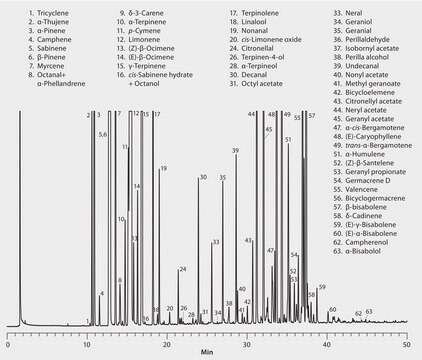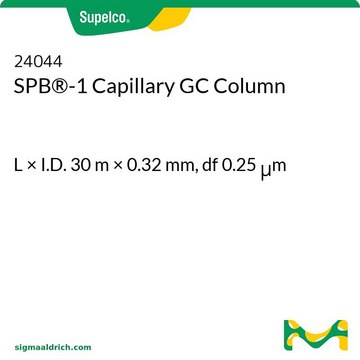24255
SPB®-624 Capillary GC Column
L × I.D. 30 m × 0.25 mm, df 1.40 μm
Sinonimo/i:
SPB-624, 30M .25MM 1.4UM
Autenticatiper visualizzare i prezzi riservati alla tua organizzazione & contrattuali
About This Item
Codice UNSPSC:
41115710
eCl@ss:
32119290
Prodotti consigliati
Materiali
fused silica
Livello qualitativo
agenzia
EPA 524.2,0030,624,8260,OLM04.2 VOA
meets requirements for USP G43
suitable for EPA 601
Parametri
≤25-250 °C temperature (isothermal or programmed)
Beta
45
df
1.40 μm
tecniche
gas chromatography (GC): suitable
Lungh. × D.I.
30 m × 0.25 mm
applicazioni
environmental
food and beverages
pharmaceutical
Tipo di colonna
capillary intermediate polar
Cerchi prodotti simili? Visita Guida al confronto tra prodotti
Descrizione generale
Application: This column is specially tested for separation, efficiency, and low bleed. It is designed for purge-and-trap analyses of volatile halogenated, non-halogenated, and aromatic contaminants from environmental samples.
USP Code: This column meets USP G43 requirements.
Phase:
USP Code: This column meets USP G43 requirements.
Phase:
- Bonded
- Proprietary
- ≤0.32 mm I.D.: Subambient to 250 °C (isothermal or programmed)
- ≥0.53 mm I.D.: Subambient to 230 °C (isothermal or programmed)
Applicazioni
SPB®-64 fused silica capillary column may be used in gas chromatography quipped with flame ionization detector (FID) in order to measure styrene level in the blood and in the cochlear samples, in an investigation to determine the distribution of styrene in the cochlea, to monitor the hearing loss and death of cochlear cells in different regions as a result of varying styrene dosage and to analyse the relative vulnerability of cochlear cells and cell death pathways after styrene exposure as styrene is ototoxic and causes cochlear damage starting from the middle turn.
Altre note
We offer a variety of chromatography accessories including analytical syringes
Note legali
SPB is a registered trademark of Merck KGaA, Darmstadt, Germany
Applicazioni
N° Catalogo
Descrizione
Determinazione del prezzo
Scegli una delle versioni più recenti:
Possiedi già questo prodotto?
I documenti relativi ai prodotti acquistati recentemente sono disponibili nell’Archivio dei documenti.
I clienti hanno visto anche
Guang-Di Chen et al.
Toxicological sciences : an official journal of the Society of Toxicology, 98(1), 167-177 (2007-04-11)
It is known that styrene is ototoxic and causes cochlear damage starting from the middle turn. However, the cellular mechanism underlying styrene ototoxicity is still unclear. In this study, rats were exposed to styrene by gavage at different doses once
Chromatograms
suitable for GCsuitable for GCsuitable for GCIl team dei nostri ricercatori vanta grande esperienza in tutte le aree della ricerca quali Life Science, scienza dei materiali, sintesi chimica, cromatografia, discipline analitiche, ecc..
Contatta l'Assistenza Tecnica.











